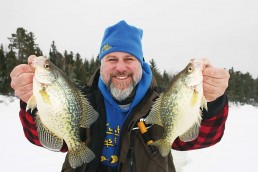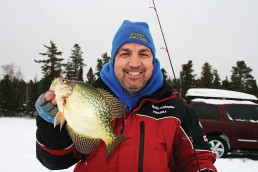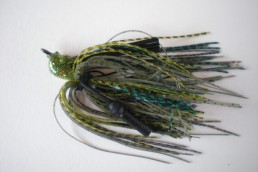No More Bluegill Trouble
SHARE THIS POST
We have chased a lot of bluegills in our days on the ice, and one thing we know for sure is we don’t know everything that is going on below. But here is what we do know: Once the ice forms, the bluegills are shallow. But this is also when weeds begin to die and the fish transition to deeper areas. And, when the ice starts to deteriorate, they’ll move back shallow once again.
Sunlight penetration affects the ice world underneath in a positive and a negative way. On clear ice, the sun keeps the weeds green in the shallows, which in turn, keeps the oxygen and the fish up. Often, that is good, but if the water is ultra-clear, the bluegills are ultra-spooky. On snow-covered ice, the sun is a good thing until those rays melt the snow and make the whole thing a sloppy mess—but sometimes those sloppy snow days are great for fishing.
So what do the bluegills do down there?
In the early season, they will relate to those green weeds. Think of it as an “underwater highway,” as they travel, make rest stops, have breakfast, lunch and dinner and continue on. Now, look for open spots near the weed edges and the bluegills can be there. With a little scouting and a little drilling, you’ll find one of their “rest stops.” You’ll know it’s one when you drop down a tiny jig and waxworm and catch a few. Now, set up a Frabill Bro hub tent over this area.
Once you have finished your setup you can use your camera and locator. Viewing the action in HD as it happens and panning a camera around to see what’s coming will help aid you in knowing when to jig and trigger the fish.
One thing you may notice right away is that an aggressive bluegill will come right up and suck the jig in without hesitation. A bigger, more tentative bluegill or lone wolf will be off to the side. She’ll move in about 3 to 4 inches away, flair her gills and then suck in the bait. If you drop your rod a little and let the bluegill suck it in, you will get it every time.
After hundreds of hours of watching bluegills eat, we have realized four things:
Are you enjoying this post?
You can be among the first to get the latest info on where to go, what to use and how to use it!
First, the largest bluegills have the softest “bite” since they are “side-suckers.” Second, these fish seem to like a jig with big eyes more than a jig with none. Third, plastics added to bait keeps the smaller, annoying fish from attacking. Finally, a jig neither horizontal nor vertical, but “vertizontal,” with the hook at a 30- to 45-degree angle, has the best hooking ratio.
When you put all of these points together in one ice jig, you get what the new multi-colored Majmun jig is all about. It comes in three sizes (by hook size), 14, 12 and 10. It also has large eyes needed for attraction. The Majmun comes in three multi-colored glow patterns and three hi-vis. multi-colors too. The “vertizontal” presentation for better hooking is attained with this hook too, plus it has a little longer shank so that the Wedgee plastic fits perfectly. It is by far our favorite new jig for bluegills. The size 14 is our go-to shallow-water jig. It’s tungsten, so it weighs 1/25 ounce, and when rigged with the Wedgee it has a nice flowing bounce as you jig it. Rig a Lemon Lime Majmun with the Black Wedgee and you have a dynamite combo. Add a spike or two for scent just like Poppee does, and you’ll have both hands busy reeling in the fish in no time.
When the barometer makes a swing after or before a storm or after a strong cold front passes, those bluegills will remain shallow, but bury themselves in the weeds. This is when a heavier jig in 1/12 ounce and in a size 10 can work best. Get a multi-colored lure without any bait and drop it down a hole with weeds. It will wiggle down the stalks and jiggle to the bottom where the stalks begin and where the big bull ‘gills are.
As the season progresses and the bluegills migrate deeper, use a larger size like 10 and 12. This is when multi-colored Majmuns really shine. In fact, the Grape color with the new Glow Brite Pink Wedgee will put the hurt on bluegills deeper than 6 feet. This species will be right on the bottom, so sometimes bouncing off the bottom can attract them. Or, if they are 3 to 6 inches off the bottom, a Majmun will catch them.
So don’t forget these recommended jigs this winter. Again, it’s our go-to bluegill jig and we’re sure it will be yours too.
Walt Matan and his father Poppee are the chief lure designers for Custom Jigs & Spins. For more information on ice fishing and to see all of Custom Jigs & Spins tackle log on to customjigs.com or call 800-831-5535 for a free, all-new catalog. You can also log on to frabill.com to check out the Ice Hunter Series rod and reel combos and the Sentinel one-man tents.
MWO
SHARE THIS POST
Did you enjoy this post?
You can be among the first to get the latest info on where to go, what to use and how to use it!
Walt Matan
Walt Matan has been a writer and television host for MidWest Outdoors for 30 years. An avid ice and open-water fisherman, he currently lives in the Quad Cities on the shores of the Mississippi River. He is the product developer and brand manager for Custom Jigs & Spins, B-Fish-N Tackle, and Rippin Lips Catfish Tackle. For more information visit customjigs.com.





